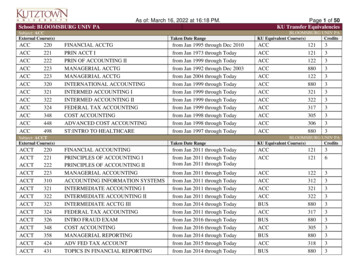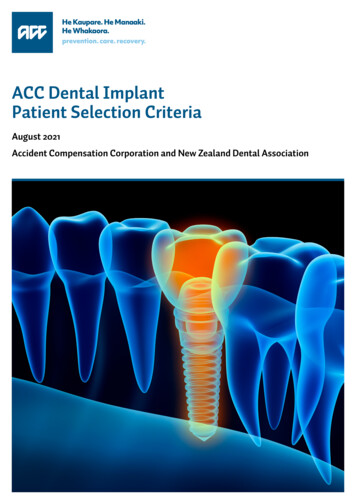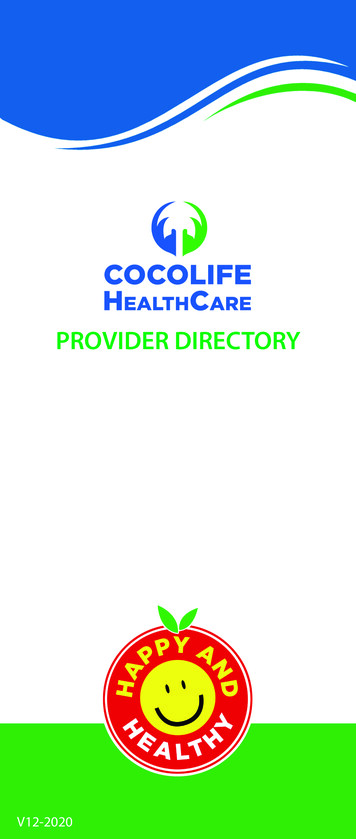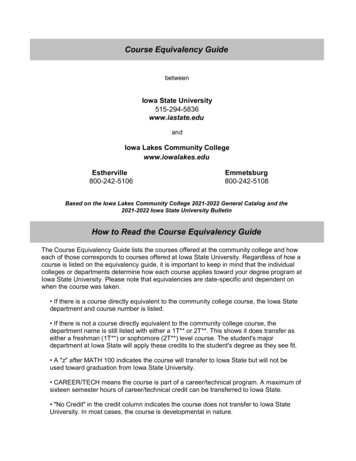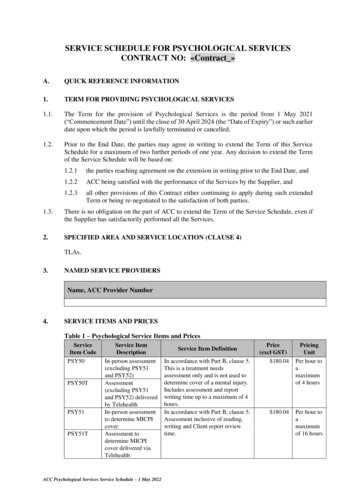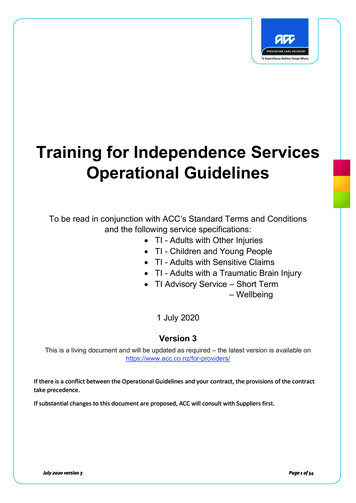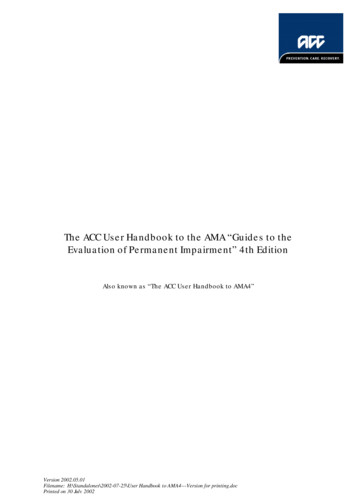
Transcription
The ACC User Handbook to the AMA “Guides to theEvaluation of Permanent Impairment” 4th EditionAlso known as “The ACC User Handbook to AMA4”Version 2002.05.01Filename: H:\Standalones\2002-07-25\User Handbook to AMA4---Version for printing.docPrinted on 30 July 2002
The ACC User Handbook to the AMA “Guides tothe Evaluation of Permanent Impairment” 4th EditionThe information contained in this Handbook is copyright to the AccidentCompensation Corporation and its successors (ACC) April 2002.All rights reserved.Additional copies may be obtained from:ACCPO Box 242WellingtonNew ZealandFirst editionFirst printing March 2002Second printing May 2002Printed in New ZealandISBN 0-478-25172-6ACC716Printed on 30 July 2002Page 3
ContentsAbout this User Handbook6ú The User Handbook. 6ú How to use it. 6ú Understanding the tables in this document . 6ú If you need help. 6Assessing impairment8ú Definition of impairment . 8ú Why use impairment . 8ú Assessment process. 8ú Inconsistency . 9ú Covered conditions. 9ú Range finding within tables. 9ú Apportionment . 10ú Assessing by analogy. 10ú Duplicating impairments . 10ú Prostheses . 10ú Adjustments for effects of treatment or lack of treatment. 10ú Report format . 11Whole-person concept12ú The whole -person concept . 12ú Functional sub-units. 12ú Further subdivisions . 12ú Multiple impairments (in same sub-unit). 13ú Combining: How it works. 13AMA4 references15ú Autonomic nervous system. 16ú Brain and cranial nerves. 17ú Cardiovascular . 22ú Digestive system. 23ú Endocrine system . 24ú ENT and related disorders . 25ú Haematopoietic system. 26ú Lower extremity (including pelvis) . 27ú Mental and behavioural . 33ú Pain. 42ú Peripheral nervous system. 43ú Reproductive system. 44ú Respiratory system. 45ú Skin. 46ú Spine . 48ú Upper extremity . 50ú Urinary tract . 53ú Visual system. 54Page 4Printed on 30 July 2002
Examples56ú Combining: Lower extremity . 56ú Range finding: Lower extremity . 58ú Range finding: Skin (example 1) . 59ú Range finding: Skin (example 2) . 60ú Range finding: Traumatic brain injury (using recommended formatting). 61Worksheets66ú Lower extremity combining worksheet . 67ú Brain and cranial nerves worksheet. 68ú Vision-testing chart (N notation) . 70ú Visual impairment worksheet . 71Index to AMA4 and the User HandbookPrinted on 30 July 200272Page 5
About this User HandbookThe User HandbookThis is ACC’s user handbook to the fourth edition of the American MedicalAssociation’s “Guides to the Evaluation of Permanent Impairment”. 1It’s for use by ACC’s independence allowance and lump sum assessors.How to use itUse the User Handbook like this:s Look up the topic you want in the index starting on page 72.s If the index specifies an AMA4 reference, go directly to AMA4. Otherwise,continue as follows.s Go to the page specified in this document and look up the relevant impairmentor disorder. (The topics in most of the tables are in alphabetical order.)s Read the information provided, including any general comments. (If there areany general comments, they’ll appear in the first row of the table.)s When you’re familiar with the issues, go to the specified page(s) in your copyof AMA4.s Read the material in AMA4, and use the tables and charts to calculate theimpairment.Understanding the tables in this documentMany of the tables in this document contain four columns, like this:This is the topic coveredin this row of the table Topic and these are subtopicsSubtopicCommentsAMA4 pageGeneral comments:s Remember to combine at the lowest common hierarchy before converting to wholeperson. Ignore the contradictory instruction in AMA4.LigamentAnkles Need stress x-rays.86 table 64s Any number of ratings from within table 64may be combined, if not duplicatingimpairment.Knee85 table 64s Cruciate and/or collateral.s Any number of ratings from within table 64may be combined, if not duplicatingimpairment. etc etcThese general commentsapply to the whole table whereas these apply to aspecific topic (or subtopic)This tells you which parts of AMA4contain information relevant to thistopic (or sub-topic)If you need helpIf you need help, contact the Branch Medical Officer (BMA) at your local branch.1. Referred to in this document as AMA4.Page 6About this User HandbookPrinted on 30 July 2002
Assessing impairmentDefinition of impairmentIn the “Injury Prevention, Rehabilitation and Compensation Act 2001”,impairment is defined as:“a loss, loss of use, or derangement of any body part, organ system, or organ function”Note that various definitions of impairment have been used by differentorganisations at different times. The definitions used by ACC have tended tomirror those used by the World Health Organisation.Note also that the definitions given in AMA4 (pages 1 and 315) differ from ACC’s.Why use impairmentImpairment provides a fair and equitable basis for determining the level of lumpsums and independence allowance. Objective and verifiable criteria are used, in astructured manner, to minimise the possibility of different assessors examining thesame person and arriving at different ratings.Although impairment is the starting point when considering disability or capacityfor work, note that impairment, disability, and work capacity are differentconcepts.The following highlights the difference between these concepts, using amputationof a little finger as an example:ConceptDisabilityWork capacityImpairmentOccupationConcert pianistGardenerConcert pianistGardenerConcert pianistGardenerImpactVery significantMinorMajorNone5%5%Keep in mind that individuals will tend to view their impairment from theperspective of its impact upon them personally (that is, their disability). Alwaysexplain the difference between impairment and disability, so they may betterunderstand the assessment’s outcome. Many assessors find the following formulahelpful:“What I am rating is the severity of your injury, not the severity of your pain.”Assessment processThe medical assessment of impairment follows this process:Step1 Gather and evaluaterelevant informationCommentss Review the following for each condition you’ve beenasked to assess:Medical recordsInvestigationsLaboratory findings23456Page 8Read relevant material inthis documentRead relevant material inAMA4Establish clinical historyand examine claimantDetermine impairment foreach conditionDetermine whole-personratings Find the topic you want by using the index (startingon page 72).s This document tells you which pages to refer to.s Rate the impairment for each condition using thetables and charts in AMA4 and relevant material fromthis document.s Using tables in AMA4.Assessing impairmentPrinted on 30 July 2002
InconsistencyKeep alert for findings inconsistent with the documentation (for example,unexpectedly good ROM). The following references in AMA4 provide advice onthis issue:Page 8 section 2.2Page 9 paragraphs 2-3Page 77 section 3.2ePage 95 section 3.3a, paragraph 1Page 112 “General measurement principles”Note any inconsistency in your report.Covered conditionsYour assessment should only rate impairment resulting from conditions coveredby ACC.The referral from ACC will indicate which conditions are covered. If you noticeanything inconsistent, however, mention it in your report. But don’t assess acondition without request from ACC.Some of the main criteria for cover are:EntitlementIndependence allowanceLump sumsCriterias Claimant suffered personal injury on or after 1 April 1974.s At least one year after the date of the injury, or conditionhas stabilised.s Claimant suffered personal injury on or after 1 April 2002.s At least two years after the date of the injury, or conditionhas stabilised.Range finding within tablesRange finding is needed when AMA4 provides a range of percentages, rather thana single percentage. (For an example, see AMA4 page 243 table 4.) Use one of thefollowing approaches to arrive at a specific percentage:ApproachBase on criteriaabove and belowBase on number ofthe criteria satisfiedCommentss If the criteria for the range are all satisfied, and the criteria forthe range above are almost satisfied, then choose a percentagetowards the top of the range.s But, if the criteria are only just satisfied, then choose apercentage towards the bottom of the range.s If there are a number of criteria, but any one of the listed criteriais sufficient, consider basing the percentage on the number ofcriteria satisfieds For example, if there are three criteria for a 0-9% range, then:If one of the criteria are satisfied, the choice would be 3%If two of the criteria are satisfied, the choice would be 6%If three of the criteria are satisfied, the choice would be 9%Note: Justify your choice in your report, quoting examples from AMA4 or fromthis document (starting on page 56) to support your decision.Printed on 30 July 2002Assessing impairmentPage 9
ApportionmentAn impairment may be the result of multiple conditions, not all of which arecovered by ACC. In this situation, apportion the percentage into covered andnon-covered impairments.Examples:MethodDeduct pre-existingimpairmentUse clinical judgementDescriptions If possible, analyse the impairment that existed prior to thecovered condition occurring, using the following method:ú Calculate the pre-existing percentage (base on medicalrecords).ú Calculate the percentage that currently exists (from thecombination of covered and non-covered conditions).ú Deem the difference between the two to be the impairmentapportioned to the covered condition.s Note that one figure is deducted from the other. Don’tattempt a “reverse combine”.s If it’s not possible to calculate the pre-existing impairment,base the apportionment on your clinical judgement, usinghistorical records and your own clinical evaluation.s Very occasionally, you won’t feel you can confidently do this.If so, note this in your report.Also read the following in AMA4:Page 10 paragraph 2Page 103 example 2Page 315 “Apportionment”Note: If you use apportionment, justify your decision in your report.Assessing by analogyIn rare circumstances, AMA4 may not quote an impairment rating. If so,determine the rating by comparison with a similar impairment of a similar bodysite.Also read AMA4 page 9 paragraph 2 of right hand side.Note: If you establish a rating by analogy, justify your chosen approach in yourreport.Duplicating impairmentsMake sure you don’t rate the same condition twice.For example, ROM can occur as a result of significant neurological impairment inan extremity, in which case the rating is based on the impaired nerve. If theimpairment is due strictly to nerve dysfunction, don’t give an additional rating forROM at the joint, as that loss is already allowed for in the nerve rating tables.ProsthesesRead AMA4 page 9 “Using prostheses in evaluations”.Adjustments for effects of treatment or lack of treatmentRead AMA4 page 9 “Adjustments for effects of treatment or lack of treatment”.Page 10Assessing impairmentPrinted on 30 July 2002
Report formatUse the following format for your report. (But for mental injury, use the report format onpage 41.) Each element must be present, and in the order specified.TopicBackgroundAssessor detailsTitle of reportCommentss Your name and contact details.s Either:Lump sum report; orIndependence allowance assessment reports Indicate in the title if the report isamended.Address to referringcase managerAppointment detailsClaimant detailsInjuriesssssDate, time, and duration of appointment.Date assessment requested by ACC.Name and DOB.List injuries for which ACC has requestedassessment:DateInjuryClaim numberDocumentations List documents received and reviewed:DateSource or authors Don’t summarise the content of thedocument in this list.ConditionMedical historyClinical examinationAnalysis and discussions Include comments and conclusions on:Permanence 2 and stability3Clinical examinationAdequacy of documentation(cover each condition separately,and repeat for each injury)Impairment ratings For each condition, list:InjuryRatingAMA4 references In these situations, also justify yourrating:Analogy usedRange finding usedMultiple methods availableApportioning (if used)ConclusionWhole-person rating(for THIS condition)Final whole-personrating(for ALL conditions)SignatureAttachmentss See “Apportionment” on page 10 of thisdocument.s Round the whole-person impairmentrating to the nearer integer.s Sign after proof reading.s For example, upper-extremity work sheets Note how many attachments are enclosedat the foot of the report.Notes:ú Make sure you number the pages of the report.ú Don’t use names of people, places, schools, etc. That is, avoid using unnecessary identifying data.2. Permanent impairment means:“A loss, loss of use, or derangement of any body part, organ system, or organ function, that is well established andunlikely to change substantially in the next year, with or without further medical treatment.”3. Stability means:“Unlikely to improve in the next twelve months.”Printed on 30 July 2002Assessing impairmentPage 11
Whole-person conceptThe whole-person conceptThe concept of whole-person impairment makes it impossible for an individual tobe more than 100% impaired.Whole-person impairment is expressed as a percentage, ranging from 0-100%. Tobe 95-100% impaired is to be in a state approaching death.Functional sub-unitsThe whole -person is divided into the following functional sub-units:MentaldisorderNervoussystemSpeechx 1.0Leftupperextremityx 1.0Visualx 0.35Hearingx 0.94x 0.35x 1.0OtherENTrelatedx 1.0Rightupperextremityx 0.6x 0.6RespiratoryWhole personx 0.4LeftlowerextremityDigestivex 1.0Hemato-poieticx 0.4x 1.0x 1.0Pelvisx 1.0Spinex 1.0x 1.0Endocrinex 1.0UrinaryandreproductiveRightlowerextremityx 1.0SkinCardiovascularBased on a model developed by G.T. Davis MDEach sub-unit has a relationship to the whole person. For example, a leg is 40% ofthe whole person. Note that the left and right arms are separate sub -units, as arethe left and right legs.Further subdivisionsSome of the sub-units have further subdivisions, and there is a hierarchy to thesesubdivisions. For example:The (right or left) arm is 60% of the whole personThe hand is part 90% of the (right or left) armThe thumb is 40% of the handThis is illustrated below:Wholepersonx 0.6Rightupperextremityx 0.9HandBased on a model developed by G.T. Davis MDPage 12Whole-person conceptx 0.4Thumbx 0.2Index fingerx 0.2Middle fingerx 0.1Ring fingerx 0.1Little fingerx 1.0Printed on 30 July 2002
Multiple impairments (in same sub-unit)Three different methods are used when a claimant has multiple impairmentswithin the same sub-unit.MethodAddingFilteringCombiningCommentss The percentages for impairments are added.s Example: Range of motion impairments at the same upper extremityjoint.s The largest of a group of impairment percentages is used to representthe total impairment for the sub-unit.s Example: Cognitive brain functions, where only the largestimpairment of the five evaluated impairments is used.s This method ensures that impairments aren’t duplicated.s Guarantees that the whole-person rating won’t exceed 100%.s Is the most commonly used method.s Described in more detail below.Note: For each sub-unit, AMA4 specifies which method to use.Combining: How it worksThis is how “combining” works:s If we take an individual with no impairment, and they lose their leg (theimpairment value for which is 40%), they now only have 60% of their wholeperson remaining.s If they then suffer a further loss of (say) the other leg, that second impairmentis deemed to be on the 60% whole person remaining. That is, the whole -personimpairment for the second leg is 24% (40% of 60% ).s The total impairment for the loss of both legs is 64% (40% for the first leg, plus24% for the second).s The remaining whole person is now 36%.(Any further impairments should be applied to 36% of the whole person.)The method guarantees that the total impairment rating for an individual can’texceed 100%, and can be expressed mathematically as:Percentage impairment A B(1 – A)where A and B are the two impairment values being combinedNotes:s The “Combined values chart” on pages 322-324 of AMA4 allows easyapplication of the formula.s When dealing with impairments that affect several parts or the same sub-unit,always start at the lowest level first, then move progressively up the hierarchy.(For example, finger, hand, upper extremity.)Printed on 30 July 2002Whole-person conceptPage 13
AMA4 referencesHow to use this chapterUse this chapter as follows:Step1234Printed on 30 July 2002Actions Go to the Contents on page 4 and select a body system (under “AMA4references”).s Go to the page number specified (in this document). For example, “ENT andrelated disorders” on page 25.s Select a topic (for example, “Facial structure”).s Read the comments for that topic (if any), then go to the AMA4 pages specified.AMA4 referencesPage 15
Autonomic nervous systemAutonomic nervous systemTopicANSSubtopicCommentsSyncopeTransient loss ofawarenessPage 16AMA4 referencesAMA4 page142 section 4.1e151 section 4.4d152 table 22151 section 4.4d142 section 4.1e152 table 22151 section 4.4d142 section 4.1d143 paragraph 4Printed on 30 July 2002
Brain and cranial nervesBrain and cranial nervesWhat this coversThis covers the brain and cranial nerves. The peripheral nervous system iscovered on page 43 of this document, and the spine on page 48.Assessment processThe assessment process for brain injuries is as follows:Step1 Interview the claimant23Physically examine theclaimantDetermine theimpairment ratingCommentss Expected output several pages in report.s Present your report as a narrative. Don’t just enclose thechecklist on page 18.s It is expected that the claimant will be accompanied atthe interview by someone who’s known them before andafter the injury, to help you obtain collateral history.s If this isn’t possible:ú Explain why not in your report.ú Also try to identify someone to obtain collateralinformation from (for example, by telephone).s The criteria are defined by the restrictions or limitationsthe impairment imposes on the patient’s ability toindependently carry out activities of daily living (exceptfor some specific injuries like vision and hearing loss).Note: An example of the report you should prepare is given on page 11.What nextContinue as follows:s Use the checklists on the following pages:Interview the claimantPhysically examine the claimantDetermine the impairment ratings Then refer to the summary of AMA4 references on page 21 of this document.s When you’re ready, use the worksheet on page 68 of this document to recordyour results.Printed on 30 July 2002AMA4 referencesPage 17
Brain and cranial nervesInterview the claimantTopicCurrent personalcircumstancesPersonal historyMedical historyMental statusexaminationActivities for dailyliving (ADL)Social functioningPage 18Checklists Marital statuss Living arrangements Partner (including their occupation)s Childrens Occupation (or, how they fill in the day)s Finances (security, in debt?)s Childhoods Milestoness Parents (relationship, occupation, treatment of children)s School and work history (self, siblings, parents)s Relationshipss Current medications Psychiatric historys Drugs, alcohol, forensics Significant medical conditions (hospital, prolonged medication)s Appearances Behaviour (normal, agitated, retarded, cooperative, appropriate)s Attitude (rapport, eye contact, frank, friendly, hostile, guarded)s Talk (monotone, limited, verbose, pressured, derail, circumlocution)s Thought (psychotic, manic, depressed)s Affects Mood (manic, depressed, angry, anxious, suspicious, euthymic, irritability,panic attacks, suicide, confidence, self esteem)s Self cares Communications Travel (able to drive car or use public transport)s Sexuals Development and maintenance of close relationships Shopping (memory, handling money, need assistance)s Eatings Sleeps Maintain residences Hobbies, music, video, TV, reading, handicraft, gardens Able to maintain social norms. Disinhibition.s Gets on with neighbours, shopkeepers, co-workers, etcs Circle of friends (visit them, have visitors)s Initiates social contactss Goes out to social functionss Groups (sports, church, etc)s Cooperative and considerates Socially responsible (care for others)s Negotiation and compromises Able to participate in group conversationss Noise intoleranceAMA4 referencesPrinted on 30 July 2002
Brain and cranial nervesTopicCognitionChecklists Task completion at home or works Planning and organisings Decisionss Judgements Bank account, budgets Concentrations MemoryRead and remember booksWatch and remember TV, serialsWatch and remember moviesKeep a diarySafe alone (leave taps running or elements on)s Folstein’s (see below).Folstein’s mini mental-status examOrientationFatigue or sleepdisorderSeizureHeadachePainPrinted on 30 July 2002Year, season, date, day, month5Country, city, suburb, PM, deputy PM5Registration Ball, flag. Tree3Get to repeat once (tests attention and registration)Calculation100-7 93, 86, 79, 72, 655OR: Spell “world” backwards ( “dlrow”)Tests attention and concentrationRecallBall, flag, tree (up to 6 tries)3Tests short-term memoryLanguageName simple objects (pencil, watch)2Repeat (no ifs, ands, buts). One try.1“Take paper in right hand, fold in half, and place on desk”3(Tests ability to follow simple three-step instruction)Read, “close your eyes”, and follow instruction1Write a sentence (with verb and noun)1Copy design (intersecting pentagons)1Must have all five angles presentTOTAL30Score 22/30: Suspect cognitive impairmentScore 17/30: Definite cognitive impairmentFor further information, see:ú Folstein, Folstein & McHugh, Journal of Psychiatric Research 1975 Vol 12pp 189-198ú International Psychogeriatrics 1997 Vol 9, Supplement 1 pp 87-94s Ask specifically about fatigue, which is an important post head-injury symptom forwhich AMA4 doesn’t make a specific allowance.s Record reported thalamic pain, phantom limb pain, and causalgia. (See AMA4page 140 “Sensory disturbances”.)AMA4 referencesPage 19
Brain and cranial nervesPhysically examine the claimantPart of bodyTopicChecklistCranial nervess See AMA4 pages 144-147 section 4 (including tables 7-12) for cranial nerve general information.IOlfactorySmells Test each nostril separately (coffee or soap)s Don’t use an irritant, because it will stimulate thepain fibres of the trigeminal nerve.IIOpticVisions Visual acuity (corrected) — near and distants Optic fundi:Visual mediaOptic discsBlood vesselsRetina and maculaVisual fieldsIIIIVVIOculomotorTrochlearAbducensExternal ocular movementsVTrigeminalFacial sensationCorneal reflexesMasseter and ptyerygoidmusclesJaw jerkFacial movementsVIIVIIIFacialAcoustic(auditory)Taste on anterior 2/3tongueHearingsssssssBy confrontationScreen, using small finger movementsPrecise delineation will require optometry reportDiplopia, dysconjugate movementsNystagmusPtosisPupils (size, shape, response to light, convergence)s To command (any symmetry)s Involuntary (as in smiling)s Sweet, salt, bitters Auditory acuity (whisper)s Tuning fork tests (if deaf)s External auditory canals and TMVestibular yXIIHypoglossalPalatal and pharyngealmovementsLaryngeal movementsSternomastoidTrapeziusTongues SwallowingssssVoice, high “eee”, coughTurn headShrug shoulderWasting, fasciculation, weakness,rapidity of movementNotes:ú Record all positive findings, and only significant negatives.ú Set out the results on a copy of the “Brain and cranial nerves worksheet” (page 68).Page 20AMA4 referencesPrinted on 30 July 2002
Brain and cranial nervesPart of bodyTopicChecklistLimbs, trunk, skull, and scalpMotor systemLookMuscle toneMuscle powerCoordinationTendon reflexess Wasting, fasciculation, posture, involuntary movements, gait,balances Record observations of functional impairment of limbs as perAMA4 page 147 section 4.3a and page 148 section 4.3b(including tables 13-15).s Any clonus?s Set muscle group, and attempt to overcome its Compare sidess Rapid alternating movementss Point-to-point movements (heel/knee/shin andfinger/nose/finger)s Arms:Biceps C5-6Brachioradialis (supinator) jerk C5-6Triceps C7s Legs:Knee L3-4Ankle L5-S1Plantar responses Touch, prick, temp, proprioception, vibrations Size, shape, scars, lumps, tendernessSensationSkull and scalpAMA4 referencesCategory1 Consciousnessand awareness23456Aphasia andcommunicationMental statusand integrativefunctioningEmotional andbehaviouralPreoccupationor obsessionMajor motorand sensory7Movementdisorders8EpisodicneurologicSleep, arousal,fatigue9Printed on 30 July 2002CommentsAMA4 page142 table 4142 section 4.1d143 “Transient loss of awarenessor consciousness”151 section 4.4d152 table 22141 table 1141 section 4.1a142 table 2141 section 4.1b142 table 3141 section 4.1cs As AMA4 doesn’t provide a table for this, usethe table of page 69 of this document instead.s For sensory abnormality, refer to the relevantsection in this document (Vision, etc).s For trigeminal neuralgias For the trigeminal nerve (but not trigeminalneuralgia), use the table on page 69 of thisdocument.s For cranial nervess For other motor and sensory abnormalitys For facial movementss For example, tremors, chorea, athetosis,hemiballismus, dystonia tone.AMA4 references145 table 9144-147 tables 7-12147 section 4.3a148 section 4.3b148 table 13-15230 table 4140 “Motor disturbances”147 section 4.3a148 section 4.3b148 table 13-15143 table 5142 section 4.1e143 table 6143 “Arousal and sleepdisorders”Page 21
CardiovascularCardiovascul
This is ACC's user handbook to the fourth edition of the American Medical Association's "Guides to the Evaluation of Permanent Impairment". 1 It's for use by ACC's independence allowance and lump sum assessors. How to use it Use the User Handbook like this: s Look up the topic you want in the index starting on page 72.


